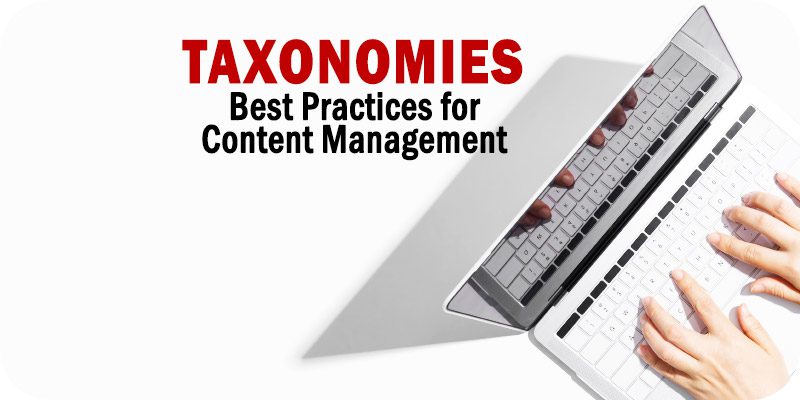Best Practices for Using Taxonomies as Solutions for Content Management


As part of Solutions Review’s Expert Insights Series—a collection of contributed articles written by industry experts in enterprise software categories—Luca Scagliarini, the Chief Product Officer at expert.ai, outlines some best practices to consider when using taxonomies in your company’s content management strategy.
 We have all suffered the frustration of not being able to access the information we are looking for quickly and easily…or at all. But how can enterprises turn the tide on data discovery and turn it into a competitive advantage? Taxonomies are a powerful enterprise content management tool. They enable organizations to deal with vast volumes of content that their users or customers want by structuring information so that products or services are easily accessible. Poor content experiences negatively influence consumer relationships and perceptions of information integrity, relevance and usefulness.
We have all suffered the frustration of not being able to access the information we are looking for quickly and easily…or at all. But how can enterprises turn the tide on data discovery and turn it into a competitive advantage? Taxonomies are a powerful enterprise content management tool. They enable organizations to deal with vast volumes of content that their users or customers want by structuring information so that products or services are easily accessible. Poor content experiences negatively influence consumer relationships and perceptions of information integrity, relevance and usefulness.
To successfully use taxonomies, we must comprehend the data discovery process.
Acknowledging the Impact of Data Discovery
The data discovery process aids in revealing insights that have been dormant inside a company by creating value out of unstructured data and making it convenient for business users to use when applicable.
Enterprises should note that any content that is challenging to find can cause users to lose trust in the content’s relevance and functionality, negating the content’s goal in the first place. As a result, this makes data discovery a high-stakes activity that needs to prioritize making content easily accessible to its consumers at all times. This can contribute to the development of actionable intelligence or information that can be used to support decision-making.
There are three aspects to consider when managing data discovery. First, enterprises should have an internal approach to provide their unique domain knowledge to customers, partners, and/or consumers so these stakeholders can leverage information toward their end goal. Overall, this helps bolster a competitive edge. Next, paying close attention to audience engagement is what keeps customers repeatedly wanting to use a company’s content over and over again. Audiences need access to accurate information they need as readily as possible. Finally, easily and efficiently accessing information is a key to differentiating in a digital environment. No matter how big or small an organization is, providing immediate and seamless access to its domain-specific information can create a competitive advantage.
Obstacles within data discovery happen when enterprises struggle to drive insights due to the absence of data structure. Content must be divided into distinct categories in a logical, organized matter, or it will become burdensome to navigate through discovery or other search methods.
Furthermore, data that has yet to be normalized or standardized and documents that originate from different sources and in several languages add to the difficulty of finding specific content when needed. Content isolated between individual data sources and dispersed across an enterprise can negatively affect an enterprise-wide strategy. This can also result in inefficient information access, causing data discovery procedures to fail and produce erroneous results that do not satisfy the demands or preferences of organizations.
Now that we have seen how data discovery can harness unstructured data to generate actionable intelligence that can help businesses make better decisions and act on them faster, the next step is using taxonomies to resolve these data discovery challenges.
Using Taxonomies to Improve Content Management
From a business standpoint, taxonomies are content management processes that enable users to quickly locate information on websites, intranets, or any other digital repositories. From a technical lens, taxonomies are systems for defining information into a hierarchical structure that matters for businesses.
Taxonomies can develop horizontally as new terms are connected with existing terms or vertically as new categories are established. Consider how the words “cloud” and “tablet” have expanded into new domains over the last decade. Remember that taxonomies are organization-centric since it structures the knowledge for the essential domains in enterprises. An individual taxonomy can be compared to a living organism that gradually evolves with an enterprise.
Taxonomies help minimize ambiguity, which is a crucial objective for any classification system. Language is ambiguous by definition. For example, the usage of the word “turn” is different in ways when it comes to operating a vehicle. It could be used to describe a motion, as in “turn left,” and also for adjusting the radio in the dashboard, as in “turn the volume up.”
Accurate taxonomies should be able to understand these concepts and give embedded domain information that enables enterprises to specify the meaning of certain words based on context. In this case, “turn” could be used to describe direction and, conversely, audio output. This ability to link concepts makes taxonomy design and implementation critical. By doing so, taxonomies enhance data discovery by giving uniformity to how content is categorized and referenced. Not only does this ensure that a variety of similar concepts is placed under proper categorization, but it also promotes transformable content into actionable intelligence.
After creating an effective taxonomy, enterprises can expect that users will find it simple to link and explore valuable content.
Build a Taxonomy Model that Meets Expectations
Leveraging taxonomies for enterprises can be tricky. The good news is that there are plenty of options to choose from depending on the expectations and technology an enterprise can support. An enterprise can use existing standard taxonomies that its industry already offers or a specific one they are targeting. There are industry-specific taxonomies (for example, IPTC for media topics and MeSH for medical themes) available to use as is or as a starting point to decrease the effort required to design and configure a taxonomy.
If the standards for the taxonomy are more specific, then consider building it from scratch to fit the needs of the organization scheme. While creating a taxonomy is labor-intensive and requires a significant commitment of subject matter expertise and time, technology exists to help jump-start the process. Some features can automatically classify any document and guarantee that they meet any criteria discussed while avoiding the expense and time of manually creating a taxonomy from square one.
Whether an enterprise chooses to build or borrow a taxonomy, it needs to ensure that several factors are made for it to succeed. This includes ensuring the taxonomy reflects its domain expertise, understanding core target users, setting up to exceed in content tagging, improving content, and keeping users updated throughout the process.
The Future of Taxonomies for Content Management
The usage of taxonomies is advancing, as are the concerns about what they can achieve and how to get the most out of them when organizing material for enterprises. Taxonomies establish the groundwork for automation, making them a critical difference for any company wanting to gain a competitive edge in operations and content management. They empower businesses to manage their information and build knowledge models to make it more useable, all while setting the infrastructure for automation to foster process efficiency, drive revenue, and make better decisions.



















